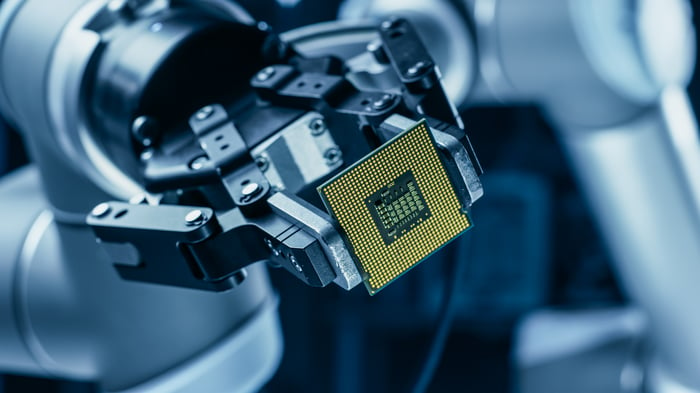Nvidia (NVDA -1.84%) is one of the world's leading chipmakers, producing best-in-class graphics cards for a variety of purposes. But it's so much more than a semiconductor company, and it is often referred to as the pioneer of artificial intelligence (AI) technology, which is just one example of its diversity.
Nvidia reports revenue under four main segments, and while gaming and the data center contribute the overwhelming majority of sales, the other two segments might be the most exciting. Here's why.

A chipmaking robot. Image source: Getty Images.
The professional visualization segment nearly doubled revenue in FY2022
If you're an active investor, you've probably heard of the metaverse. It describes a collective of virtual worlds where users can exist as avatars of themselves, teleport to different experiences, and trade digital goods and services.
But virtual reality has far more applications than just the metaverse. Nvidia sees diverse end markets in entertainment (gaming and movies), and even in industrial settings. The company's Omniverse platform is a powerful creative tool for developers of virtual worlds, no matter their purpose.
Industrial uses are among the most intriguing, as more large companies adopt Omniverse to create digital twins of their real-life assets. It allows them to map out different configurations on their factory floors with millimeter accuracy, for example, before making physical alterations.

Nvidia's professional visualization segment is home to its Omniverse platform for reporting purposes, and after flatlining growth over the last few years, revenue nearly doubled in fiscal 2022. That made it the fastest-growing of all four of Nvidia's segments for the year, but it might just be warming up.
For believers in the metaverse, for example, an estimate by Bloomberg values that opportunity alone at $800 billion by 2024. So while gaming and the data center have historically done Nvidia's heavy lifting, it might not stay that way over the long run.
The automotive and robotics segment has huge market potential
Autonomous vehicles are another hot subject in the investment community. Self-driving technology is the holy grail for carmakers like Tesla, as it opens the door to endless opportunities in mobility and freight.
Even though it doesn't manufacture cars, Nvidia is one of the leaders in this area. The chart below might not reflect that statement, but investing is about the future, and I'm going to tell you why you should be excited.

Nvidia says the revenue numbers you see above primarily reflect infotainment technology (in-car digital features), and that the future of this segment will be driven by autonomous vehicles -- and it already has $8 billion of sales in the pipeline.
In fact, automakers are flocking to Nvidia for their self-driving needs. In 2024, a brand-new generation of Mercedes-Benz vehicles will hit the road featuring Nvidia's autonomous technology. That's in addition to Tata Motors' Jaguar and Land Rover brands from 2025. Plus, innovative electric-vehicle maker Nio has built its ET5 sedan on the Nvidia DRIVE Orin chips.
According to some estimates, the market for autonomous vehicles could exceed $2.1 trillion by 2030, and Nvidia has positioned itself as the go-to player for carmakers in need of the hardware and software technology to bring it to life.





